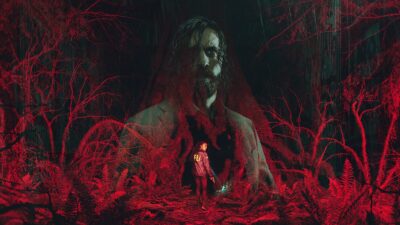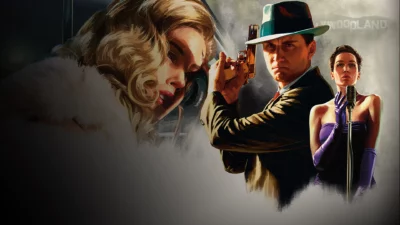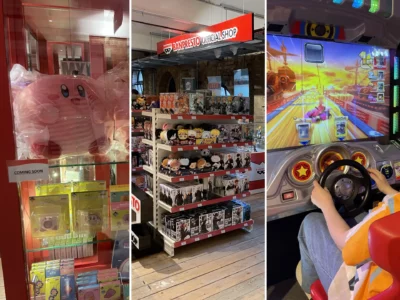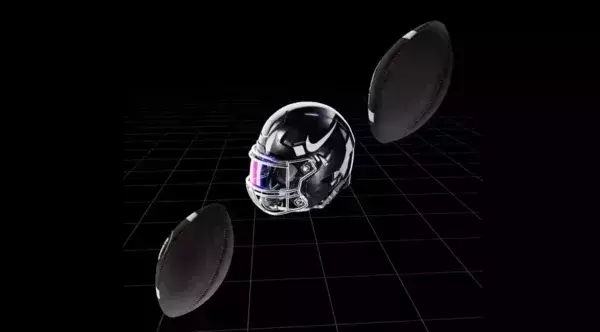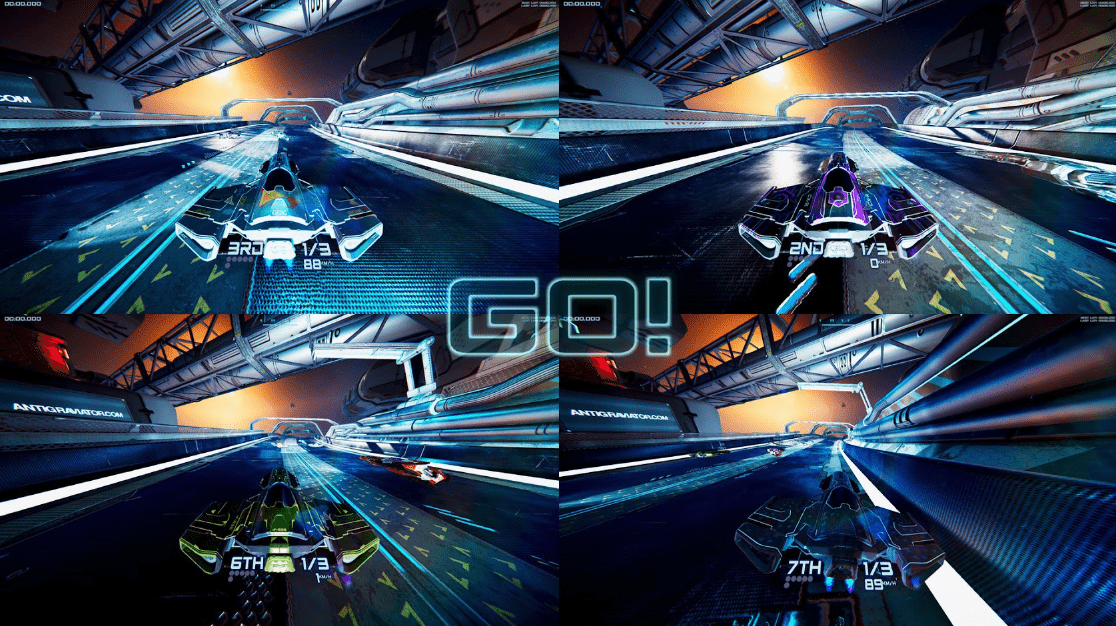
WipEout hasn’t had a sequel in years, but a generation of indie developers are queuing up to channel its anti-gravity racing sprit…
Few video game genres exist where you can draw a clear line from origin all the way up to the reputation and prominence it still has today. The anti-gravity racer, however, by nature of it being so niche in its mechanics and distinct in design, is one of them. It was in 1990 specifically, with the launch of F-Zero on the SNES, that mass audiences got their first taste of what it could feel like to reach high-octane speeds without the use of wheels, instead using a ship’s thrusters combined with the Earth’s natural forces to zoom past racing rivals amidst a swathe of futuristic environments.
This baton was eventually picked up and brought into the full 3D space thanks to the polygonal power of PlayStation, when a group of ten or so developers at Psygnosis (later renamed Studio Liverpool) unleashed the very first WipEout onto the scene. Praised at the time for its pulsing electronica soundtrack, technical controls, and sleek art direction, players quickly found themselves hypnotised by its fast-paced gameplay and stylised vision of 2052 that saw pilots compete in the fictional F3600 Anti-Gravity Racing League. It isn’t hyperbolic to say the game ushered in a completely new sub-genre of racer, resulting in countless sequels and spin-offs – even gracing a Nintendo console in the form of WipEout 64 in the exact same year as the platform’s own F-Zero X.
So influential on the racing scene was Studio Liverpool’s series, it continued to develop new entries up until the launch of 2012’s WipEout 2048, aptly as a launch title for the PlayStation Vita. Since then, though, the grandaddy of anti-gravity racers has largely remained silent, with the last official instalment being WipEout Omega Collection in 2017, which itself is merely a remastered compilation featuring two previously released titles alongside a polished-up expansion. The series now only exists in the form of a simplified mobile game launched earlier this year: WipEout Merge. And while this Sony-licensed spin-off might aim to do the franchise’s legacy justice, it can’t deliver the high frame rates and crisp visuals WipEout eventually became synonymous with. For that, veteran players now have to look elsewhere.
Total WipEout
“Our goal has always been to ‘race faster than ever’, to create the most thrilling anti-gravity racing experience possible [and] the fastest racing game of all time,” explains Giuseppe Franchi, lead game designer on Redout, an indie-made spiritual successor to WipEout in all but name. Its sequel launched earlier this year with a greater emphasis on tight controls, blindingly fast speed, and a bigger effort to hook in genre newcomers. Whereas the original released the same year as WipEout Omega Collection, there’s
a sense that Redout 2 was finally able to step out of the shadows and come into its own.
“[We wanted] something that would remind old players, like ourselves, of the excitement they felt when playing the classics. We’ve definitely achieved something on that front according to how the game was received, and we are very happy with that.”
Much like the series that inspired it, Redout 2 presents players with a litany of anti-gravity vehicle classes to unlock, coupled with the sub-genre’s typical bright visuals and seriously fast gameplay. The team at 34BigThings’ entire ethos is simply ‘faster equals better’, as it tries to – literally and figuratively – blow past people’s expectations of what a modern anti-gravity racer can be. They’re also aware of staying true to the WipEout legacy without being afraid to iterate, providing it makes sense. For instance, one area where the Redout series makes a signification change is via the removal of weapons and power-ups, allowing them to focus on high-speed racing in its purest form – something that’d be unfathomable in WipEout.
One area where you can’t compromise, Franchi says, is in how a future-set anti-gravity racer feels to play. “It’s a ‘simulative experience’ that has very loose anchors to reality,” he explains. “When making an on-road game, you can have as many references as you want, even physics models pre-packed and ready. With an anti-gravity racing game, you have to work on a driving model that is basically made from scratch, but needs to be believable. With Redout, we used mainly drones as a base reference; with Redout 2, we integrated elements of airplane flying and also car racing, to make the model a little more familiar for a larger public.”
Nailing such crucial elements as the weight of these anti-gravity vehicles, a strong sense of momentum, and the iron-clad controls needed to help players feel confident they can make such tight corners, is crucial for any genre entry. After all, much of the reason why people remember the WipEout experience so fondly is due to how distinct it feels compared to racers that keep you grounded on the Tarmac. With no road to worry about, you’re not at the mercy of how fast your vehicle’s wheels can spin, but games like indie anti-gravity racers prove it’s also important to adhere to your fictional universe’s own rules.

Pacer enables you to make use of a double boost, which comes in handy when deployed on a safe straight section of the track.
Stay on track
Sometimes it’s the exaggerated nature of the tracks themselves that influence how ships in this type of racer should handle. This is something Carlton Gaunt, lead designer on R8 Studios’ 2020 game Pacer, knows all too well. “Anti-gravity racing games will routinely have tracks that twist, are shaped unusually, or are inverted for long periods of time, long past the point where momentum would keep your ship on the track,” he says. Despite WipEout establishing the basics of how physics should function three decades ago, there are lessons still to be learned. “We needed to find out how to make tracks that transition between, say, flat and sideways in a way that players can see and navigate. We also need to find a different way to keep the ship ‘on-track’ and define where the seams between being on-track and detached from the track – ‘in the air’ – are and how the transition is handled in a way that makes it fun.
“In an on-road racing game, players bring this understanding with them: if you’re at speed and the elevation of the track drops sharply, you’ll be in the air. If the track leans too far in one direction, you’ll have difficulty staying on and may slide off or fall off. This is less so in anti-gravity racing; these elements are still present, but we need to work out when and where those rules apply, where they don’t, and how we communicate this to the player. Once we have those rules established, we need to work out how to break them; we have sections in some tracks that force you to stay ‘on-track’, which need clear signposting and consistent rules for players to understand and have fun with them.”
The reason why so much thought goes into nailing how these indie genre revivals control is because creatives like Gaunt and Franchi recognise just how fervent and detail-orientated anti-gravity racing fans can be. They’re fans themselves, after all, and the template for the way factors like speed, boosting, and braking should be presented was forged when WipEout first débuted in 1995. Pacer pitches itself as an out-and-out anti-gravity racer like a lot of other indie successors, sure, but it maintains the emphasis on weapons and even uses it to focus on the area it’s most interested in: player customisation.
“The earlier F-Zero and WipEout games were improved on by their own developers through their sequels, [and they] did an incredible job of it,” acknowledges Gaunt. “We wanted to explore an alternative which we thought was more fitting to us, given our competitive intentions for the game. It is vital in that context that the player feels like their decisions are deciding the results: that a player’s strategy in customising their ship and their weapons, and the actions of everyone racing, are why each player is in their final position. Everything has to feel earned or lost through one’s own action or inaction, and if players believe that a lucky Quake weapon that was saved by a player decided the outcome, that does not make for a good, competitive-feeling race.”
Inverted expectations
Of course, this isn’t to say that R8 Studios’ way of doing things is better or worse, just that it’s more in line with the team’s goals for Pacer. Because in whatever way you look at it, just as the original WipEout was primarily conceived and created by ten people, the development teams being so small and the genre appealing to such a niche audience base means you always have to pick your battles, both in terms of creativity and technology. After rebranding from Formula Fusion to Pacer and eventually launching the game in 2020, for instance, R8 Studios soon closed down after not being able to muster enough sales to warrant a sequel. This is despite the team having a lot of ideas for the original left on the cutting-room floor.
“Ranked Mode, a skins system, statistics-driven community goals, music reactive game elements, and portal racing, to name a few,” Gaunt reveals, looking back. “Ranked Mode is probably the largest feature we didn’t get to complete: the designs were drawn, the visuals were made, and we had matchmaking in place that worked, but we never got to the player numbers themselves. We had committed during development to try and maintain a stable 60 fps, as we understood that would enhance the sensation of speed and how smooth the entire experience would feel. Getting that with the visuals we wanted meant that we could not increase the racer count much further.”
Some WipEout successors, like Cybernetic Walrus’ Antigraviator, is rooted in so much passion (as opposed to the desire to achieve commercial success) that it started out as a student project. “We knew most other students were making platform games, so we thought it would be cool to make something different,” says CEO Mike Coeck. “Once we started looking into racing games, we quickly realised that anti-gravity racers deserved a game with newer-gen graphics.” Much like the other two games discussed, the studio was adamant on retaining the cool aesthetic and design of the grav ships typically associated with the genre, but it wasn’t without restrictions. “Sadly, Antigraviator was made on a very small budget, otherwise we could have implanted many more cool ship ideas.”

In order to focus fully on the technical approach to racing, Redout 2 does away with outlandish weapons and power-ups.
Nice but niche
This leads us to a wider question: is the anti-gravity racing genre forever destined to be relatively niche and therefore endlessly strapped by budget, or could it ever muster enough excitement and passion from a large enough pool to truly break through and be considered mainstream? Most likely, it’s a case of the indies following in WipEout’s wake wanting to remain true to the blueprint set by Studio Liverpool, offering up appreciated tweaks without straying too far from what makes the series special. The issue is, despite going some way to educate newcomers on how the anti-gravity racing mechanics work via tutorials and the like, the learning curve for these games has always been extremely steep. Reaching the point where you can blister around corners and down straights at speed without bumping the sides is part of the charm and takes time, but is core to the sub-genre’s identity.
“On the whole, though, racing games are niche, and anti-gravity is a further niche of that niche. Outside of Mario Kart, Need for Speed, and Gran Turismo, most other racing game franchises just aren’t as well-known or well-sold,” says Gaunt. He suggests this needn’t necessarily be a bad thing, though. “It allows indie studios to move in and create within an established genre with good reference titles and a fan base in place that want more – this combination is a rare opportunity to create with some mitigation of risk. This means that the genre will be experimented with more and we will see more unusual ideas and concepts implemented.”
The lack of sales is something that Valerio Di Donato, 34BigThings CEO and executive producer on Redout 2, also acknowledges as a reason why the genre isn’t more widely recognised and celebrated. “Anti-gravity racing is a very niche genre, full of real hardcore and passionate players,” he says. “But niche also means low sales numbers, and it’s hard to justify something to big corporations [where the potential for] profit comes with a high financial risk.” Coeck goes one step further, suggesting that the game’s small fan base may be precisely why the WipEout and F-Zero franchises are nowhere to be seen: “I guess [it’s] a big risk to make it a big-budget title for the likes of Nintendo or Sony.” Is the remedy as simple as giving developers more money? “As with any game, if handled properly, it could break out into the mainstream,” Coeck continues. “But I feel it will need a good-sized budget to do so.”

BigThings acknowledges that Redout 2 has an incredibly high skill-ceiling, including a tutorial before letting you play the Career mode.
To the future
By and large, the creators behind Redout 2, Pacer, and Antigraviator concur that the racing games they enjoy making are (mostly) forever destined to appeal to a small, but undoubtedly passionate audience – and going in, they know that. The fact that all three teams are committed to continuing WipEout’s legacy despite this sentiment, then, only makes each of their contributions to the anti-gravity racing genre even more impressive, and the result of true collective passion.
It’s not lost on them just how much responsibility comes with evoking a series that means so much to a lot of people, whether that’s through super-sleek and futuristic grav ship designs, easy-to-learn but hard-to-master flight controls, or an ever-pulsating techno soundtrack. “Anti-gravity racers have been a hugely successful and loved genre for many generations now, so filling the void left by the franchises that gave birth to it has been a massive challenge for the team,” says Redout producer Filippo Gabello. “The first Redout has been very well received over the years and it cultivated a passionate community that allowed us to feel more comfortable with Redout 2.”
And regardless of whether WipEout or F-Zero return and attempt to reclaim the crown for a sub-genre they helped create, it’s clear that indie developers – as fans first and foremost themselves – are happy to give back to the genre and audience that gave them so much. “Being able to create in the anti-gravity racing space meant a lot to me personally,” sums up Gaunt. “I played a lot of F-Zero, WipEout, Rollcage, and Extreme-G, to name a few, when I was growing up. Working on Pacer allowed me to understand better why I loved those games, what made them work, what made them fun, to create something in the same space, and then share that creation with others. I am proud of the team we had and the game we made.”


